英语专业语言学课件
- 格式:doc
- 大小:54.50 KB
- 文档页数:4

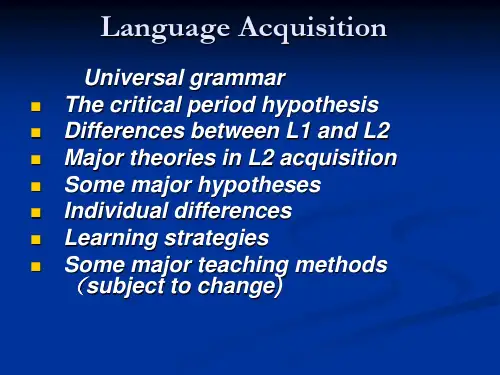
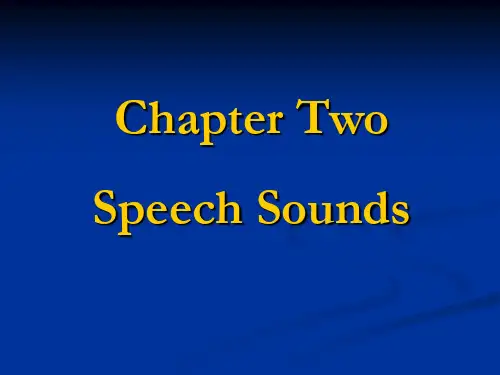
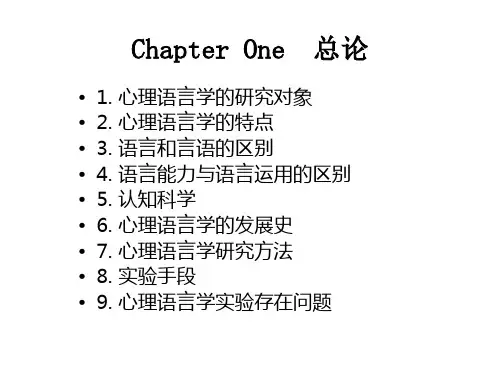



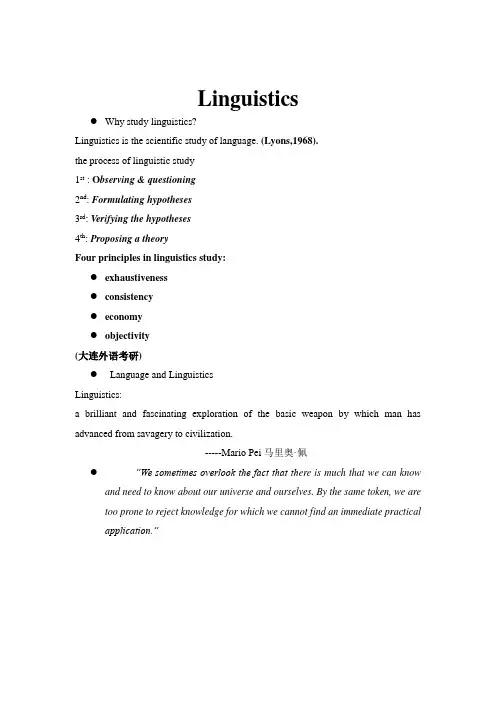
Linguistics●Why study linguistics?Linguistics is the scientific study of language. (Lyons,1968).the process of linguistic study1st : O bserving & questioning2nd: Formulating hypotheses3rd: Verifying the hypotheses4th: Proposing a theoryFour principles in linguistics study:●exhaustiveness●consistency●economy●objectivity(大连外语考研)●Language and LinguisticsLinguistics:a brilliant and fascinating exploration of the basic weapon by which man has advanced from savagery to civilization.-----Mario Pei马里奥·佩●“We sometimes overlook the fact that th ere is much that we can knowand need to know about our universe and ourselves. By the same token, we are too prone to reject knowledge for which we cannot find an immediate practical application.”Chapter 1When we study human language, we are approaching what some might call the “human essence”, the distinctive qualities of mind that are, so far as we know, unique to man. (Noam Chomsky, 1972, Language and Mind)●乔姆斯基(Noam Chomsky, 1928--)●“Chomsky is currently among the most-cited writers in all of the humanities(behind only Marx, Lenin, Shakespeare, Aristotle, Plato, and Freud) and the only living number of the top ten.” (Pinker,1994)● 1. What is Language?●Definitions of Language:Language is a system of arbitrary vocal symbols used for human communication.Key words:Language as systemSound <Phonetics发音学< Phonology 音韵学Structure <morphology 形态学<Syntax 句法学meaning <Semantics语义学<Pragmatics 语用学●Definitions of Language:●Language is a means of verbal communication.It is instrumental; it is social and conventional.(P3)2.Origin of language●The …Divine‟ origin:●The “bow-wow” theory “汪汪理论”●Imitation of the sounds of the animal●OnomatopoeicProblematic (P9)●The “pooh-pooh” theory噗噗理论●instinctive sounds of pain, anger and joy.●interjections●Problematic (P9)●The “yo-he-ho” theory“哟-嗬-哟理论”rhythmic grunts●Problematic (P9)● 3. Design Features of Language●Design features (本质特征) refer to the defining properties of human languagethat distinguish it from any animal system of communication. (P4)●Language distinguishes human beings from animals in that it is far moresophisticated than any animal communication system.● 2.Design features2.1 Arbitrariness2.2 Duality2.3 Creativity2.4 Displacement● 1. Arbitrariness●--Ferdinand de Saussure 索绪尔(Swiss)●the forms of linguistic signs bear no natural (logical, intrinsic)relationship to their meaning●At lexical level:词汇层面“A rose by any other name would smell as sweet.”---Shakespeare in Romeo and JulietCan onomatopoeia change the arbitrary nature of language?●at the syntactic level●language is not arbitrary at the syntactic level.●(a) He came in and sat down.●(b) He sat down and came in.●(c) He sat down after he came in.Arbitrariness and convention●Duality(双重性)●Duality means that language has two levels of structure, the primary leveland the secondary level.●At secondary level are elements which have no meaning but which combine toform units at primary level which do have meaning.●Secondary level is made up of meaningless sounds, and primary level ofmeaningful words.●Does the traffic light system have duality?Creativity (创造性)Recursiveness (递归性)means that one sentence can expand into endless possible sentences in a way of recurring.Displacement (移位性)●Displacement enables us to talk about a wide range of things.Unlike animal communication systems, human language is ()(电子科大2003考研)(p8)A.Stimulus freeB.Stimulus boundC.Under immediate stimulus controlD.Stimulated by some occurrence of communal interest4. Functions of language1 Informative(信息功能)2 Interpersonal function(人际功能)It embodies the use of language to express, establish and maintain social relations. The ways you talk to different people show your social status.3 Performativ e (施为功能)It means that language is also used to “do things”, to perform actions.It is primarily to change the social status of a person, or the state of a thing.4 Emotive function(感情功能)It is the use of language to reveal some feelings and attitudes of the speaker.5 Phatic communion (寒暄功能)It refers to language used for maintaining social contact rather than exchanging information or ideas.6 Recreational function (娱乐功能)It refers to the use of language for the sheer joy of using it.7. Metalingual function (元语言功能)The metalingual function is used to clarify meanings or what the other personhas said.5. Important Distinctions1 Descriptive vs. prescriptive2 Synchronic vs. diachronic3 Langue vs. parole4 Competence vs. performance1 Descriptive vs. Prescriptive (描写式和规定式)A linguistic study is descriptive if it describes and analyses facts observed; it is prescriptive if it tries to lay down rules for correct behavior.The description of a language at any one time is a synchronic study; the description of a language as it changes through time is a diachronic study.__________ studies a particular state of language;__________ studies the historical development of a language.Parole refers to the realization of langue._______: abstract_______: specific_______: stable and systematic_______: subject to personal and situational constraintsAs a social product, langue is a set of conventions that members of a speech community seem to abide by. Parole, on the other hand, is the concrete use of the conventions.Competence is the language user’s intuitive knowledge of his language.Performance is the actual realization of this knowledge in utterances.A speaker’s competence is s_____, but his performance is often influenced by p___________ factors.Where does the knowledge of language come from?Chomsky’s solution is to invoke the innate properties of the mind.What is the difference between these two pairs of distinction?Similarity:Difference:Saussure looks at language from a ___________ point of view;Chomsky looks at it more from a _____________ point of view.According to Saussure and Chomsky, which should be studied, the abstract knowledge or the actual speech?The significance of these two distinctions lies in defining the task of linguistics, which is to discover langue from instances of parole, to discover the language knowledge of the speaker from his performances.。

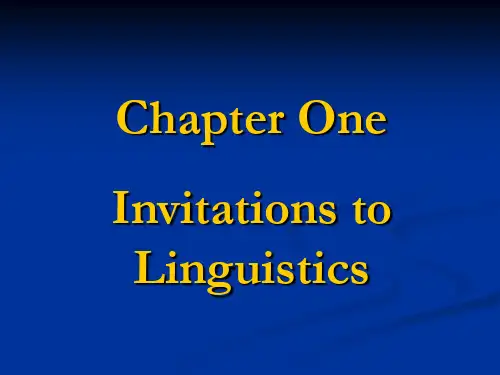
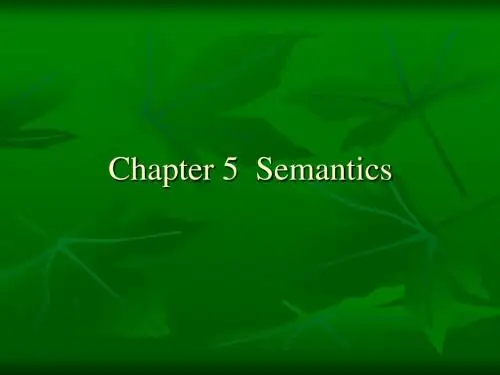
英语语言学第二章讲课课件一、教学内容本节课我们将学习英语语言学第二章,主要内容包括:语系与语言分类、语音学与音系学基础、以及词汇学初步。
具体涉及教材第二章的13节,重点探讨语言的起源、语言如何通过语音和词汇表达意义,以及不同语言之间的相似与差异。
二、教学目标1. 理解世界主要语系的特点及其分类依据,能列举至少三种语系并说明其代表性语言。
2. 掌握语音学基本概念,识别不同语音特征,并能在实际语境中进行应用。
3. 运用词汇学知识分析词语构成,提高词汇理解和运用能力。
三、教学难点与重点重点:语音学基本概念、词汇学的主要理论。
难点:语音的发音规则、词汇在不同语境中的应用。
四、教具与学具准备教具:PPT展示、录音机、语音示例CD。
学具:笔记本、词典、语音学基础教材。
五、教学过程1. 导入(5分钟):通过展示世界地图,引入不同地区语言的多样性,激发学生对语言起源和分类的兴趣。
2. 理论讲解(20分钟):介绍语系分类、语音学基础和词汇学构成,结合教材第二章13节内容。
3. 实践情景引入(10分钟):播放不同语言的问候语录音,让学生体验语言差异。
4. 例题讲解(15分钟):讲解语音学中元音、辅音的分类及发音规则,通过例词进行示范。
5. 随堂练习(10分钟):分组进行语音模仿和词汇构造练习。
六、板书设计1. 语系与语言分类印欧语系汉藏语系阿尔泰语系2. 语音学基础元音与辅音发音规则3. 词汇学初步词根、词缀词语构成七、作业设计beautifulunderstand2. 答案:beautiful: beauty, beautifully, beastunderstand: understanding, understandable, misunderstand八、课后反思及拓展延伸1. 反思:关注学生在课堂上的参与度,针对语音模仿环节进行教学调整,提高学生的发音准确性。
2. 拓展延伸:鼓励学生课下阅读更多关于语音学和词汇学的资料,了解语言的发展趋势及其背后的文化因素。
Linguistics is a systematic study of language. •Language is a system of verbal, arbitrary symbols for human communications.3. Design features of languageDesign features: the features that define human languages.▲arbitrariness▲duality▲creativity▲displacement4. Do animals have languages?5. Perspectives of language studiesLanguage involves three activities:a. Human brainb. muscular activity of the bodyc. social activity•5.1 Language as innate天生的human knowledge Noam Chomsky (1928-)•Institute Professor; Professor of Linguistics Language Acquisition Device (LAD) or Universal Grammar (UG)language acquisition is innately(biologically ) determined, that we‘re born with a genetic capacity that predisposes us to a systematic perception of language around us, resulting in the construction of an internalized system of language. (innateness hypotheses)•Cook(1985) defines UG as being made up of ―the language properties inherent in the human mind.‖•There are 2 components which contribute to language acquisition:※the innate knowledge of the learner (UG: principles)※the environment (parameter)•5.2 Language as a fixed codeLanguage is a code, namely, it is the sets of phonological, morphological, syntactic and semantic rules that, together with the lexicon, can be used to construct any or all sentences of a language; •when these sentences are combined into larger units, we get texts.•5.3 Language as a system•5.4 Language as interaction•― Language and communication are the two sides of the sa me coin‖.Implications for classroom teaching •(1)to provide opportunities for communication. ••(2)To provide opportunities for group work.6. Functions of language•6.1 Referential functionInformational信息的, or referential指示的, or ideational概念的function is associated with what objects and ideas are called and how events are described.•6.2 Interpersonal functionIt is concerned with interaction betw. the addresser and addressee in a discourse 交谈situation and the addresser‘s attitude toward what he speaks or writes about.•6.3 Performative function•6.4. Emotive function (in the hearer)•6.5 Phatic communion•Different cultures have different topics of phatic交流感情的communion:6.6 Recreational function7. Important distinctions in linguisticsLinguistic pairs(1) Competence能力& Performance表现Competence: one‘s underlying潜在的knowledge of a system, event, or fact; non-observable ability to do sth., to perform sth.•Performance: overtly明显的observable and concrete manifestation or realization of competence; the actual doing of sth.Language competence and performance •(2) Descriptive(描述式) vs. prescriptive (规定式)• A linguistic study is descriptive if it describes and analyses facts observed; it is prescriptive if it tries to lay down rules for ―correct‖ behaviour.•Put it differently, if a linguist talks about ―what is in language or ―what people actually say‖, he is descriptive; if he tells people ―what should be in language‖•Or ― what people should say‖, he is prescriptive.(3) Synchronic (共时)and Diachronic (历时)The description of a language at some point in time is a synchronic study; the description of a language as it changes through time is a diachronic study.(4) Langue and paroleThis is a distinction made by the Swiss linguist F. de Saussure early last century. Langue refers to the abstract linguistic system shared by all the members of a speech community; Parole refers to the actualized language, or realization of langue.•Langue: the structure of the language •Parole: the actual utterances•This pair is similar to the pair of competence and performance.Session 2: major branches of linguistics •1. Phonetics语音学and phonology音韵学Phonetics is the science which studies the characteristics of human sound-making, especially those sounds used in speech, and provides methods for their description, classification and transcription录音.◆articulatory phonetics(发音语音学)auditory phonetics(听觉语音学) •acoustic phonetics(声学语音学) •Phonology is the study of sound systems–the inventory of distinctive sounds that occur in a language and the patterns into which they fall. Phonology identifies the set of speech sounds for each language, how they are arranged to form meaningful units, and the function of each sound..Phonology reveals what the possible combinations of sounds in a language are and explains why certain words take the form they do.2. Morphologythe branch of linguistics that studies the internal structure of words and the rules by which words are formed.•3. Syntaxthe study of how sentences are properly formed out of words of a language.4. Semanticsthe study of meaning•5. Pragmatics•In daily conversations, we see participants successfully communicating because they share certain kinds of ―background information‘ and expectations: each other‘s ‗biographies‘, the way conversations are organized, how they are to interpreteach other‘s meanings and intentions,•how they can regulate and co-ordinate turn-taking, what and how they must contribute in order for the conversation to work.•In other words, participants reveal their linguistic and communicative competence in relating linguistic forms to the context of the communication and in using their cognitive ‗powers‘ to work out logically the state of play of the interaction. the study of meaning in actual situations; sp eaker‘s meaning, utterance meaning or contextual meaning; language in use.Pragmatics = meaning - semantics Pragmatics: the study of the use of language in communication, particularly the relationship between sentences & the contexts and situations in which they are used. It includes the study of :Morris(1976) distinguishes syntax, semantics and pragmatics in the following way:Syntactics (syntax): the relation among linguistic signs。